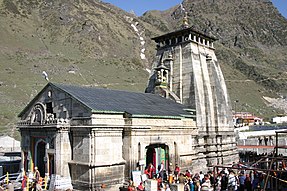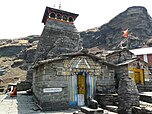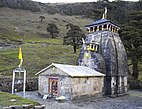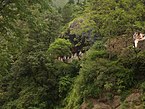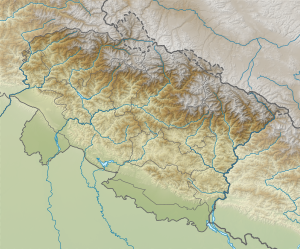
Badrinath is a town and nagar panchayat in Chamoli district in the state of Uttarakhand, India. It is a Hindu holy place, and is one of the four sites in India's Char Dham pilgrimage. It is also part of India's Chota Char Dham pilgrimage circuit and gets its name from the Badrinath Temple.
The Chota Char Dham is an important Hindu pilgrimage circuit in Uttarakhand, in the Indian Himalayas. Located in the Garhwal region of the state of Uttarakhand, the circuit consists of four sites—Gangotri, Yamunotri, Kedarnath, and Badrinath. Badrinath is also one of the four destinations of the longer Char Dham from which the Chota Char Dham likely draws its name.

Triyuginarayan Temple is a Hindu temple located in the Triyuginarayan village in Rudraprayag district, Uttarakhand, India. The ancient temple is dedicated to god Vishnu. Its fame is credited to the legend of god Shiva’s marriage to goddess Parvati witnessed by Vishnu at this venue and is thus a popular Hindu pilgrimage sites. A special feature of this temple is a perpetual fire, that burns in front of the temple. The flame is believed to burn from the times of the divine marriage. Thus, the temple is also known as Akhand Dhuni temple.

Rudraprayag is a city and a municipality in Rudraprayag district in the Indian state of Uttarakhand. Rudraprayag is one of the Panch Prayag of Alaknanda River, the point of confluence of rivers Alaknanda and Mandakini. Kedarnath, a Hindu holy city is located 86 km from Rudraprayag. The man-eating Leopard of Rudraprayag hunted and written about by Jim Corbett dwelled here.

Kedarnath Temple is a Hindu temple, one of the twelve jyotirlinga of Shiva. The temple is located on the Garhwal Himalayan range near the Mandakini river, in the state of Uttarakhand, India. Due to extreme weather conditions, the temple is open to the general public only between the months of April and November. During the winters, the vigraha (deity) of the temple is carried down to Ukhimath to be worshipped for the next six months. Kedarnath is seen as a homogeneous form of Shiva, the 'Lord of Kedarkhand', the historical name of the region.
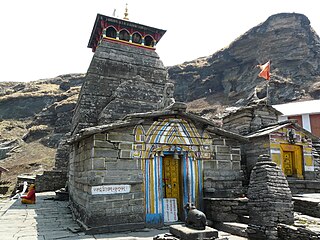
Tungnath (IAST:tuņgnāth) is one of the highest Shiva temples in the world and is the highest of the five Panch Kedar temples located in the Rudraprayag district, in the Indian state of Uttarakhand. The Tungnath mountains form the Mandakini and Alaknanda river valleys. It is located at an altitude of 3,690 m (12,106 ft), and just below the peak of Chandrashila. It has a rich legend linked to the Pandavas, heroes of the Mahabharata epic.

In Hinduism, the yatra (pilgrimage) to the tirthas has special significance for earning the punya needed to attain the moksha (salvation) by performing the darśana, the parikrama (circumambulation), the yajna, the Dhyana, the puja (worship), the prarthana, the dakshina, the seva, the bhandara, etc. These sacred places are usually located on the banks of sacred waters, such as sacred rivers or their tributaries, the kundas, the ghats, or the stepwells, or the temple tanks.

Deoria Tal is a lake about 3 km (1.9 mi) from the villages of Mastura and Sari on the Ukhimath-Chopta road in the state of Uttarakhand in India. Situated at an altitude of 2,438 metres (7,999 ft) in the Garhwal Himalayas, it has heavily wooded, lush green surroundings with snow-covered mountains in the backdrop. It is sacred to the vast population of India, such as the Hindus, Jains, Buddhists and Sikhs and other sects.
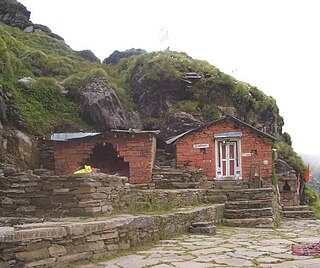
Rudranath is a Hindu temple dedicated to God Shiva, located in the Garhwal Himalayan mountains in Uttarakhand, India. Located at 3,600 metres (11,800 ft) above sea level, this natural rock temple is situated within a dense forest of rhododendron dwarfs and Alpine pastures. The temple is the second temple to be visited in the Panch Kedar pilgrimage circuit, comprising five Shiva temples in the Garhwal region to be visited in a strict pecking order starting with Kedarnath at an altitude of 3,583 m, the Tungnath (तुंगनाथ)(3,680 m or 12,070 ft), Rudranath (रुद्रनाथ), Madhyamaheshwar (मध्यमहेश्वर) and Kalpeshwar (कल्पेश्वर).
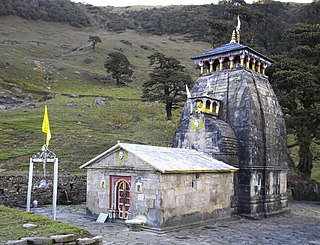
Madhyamaheshwar or Madmaheshwar is a Hindu temple dedicated to Shiva, located in Gaundar, a village in the Garhwal Himalayas of Uttarakhand, India. Situated at an elevation of 3,497 m (11,473.1 ft), it is one of the Panch Kedar pilgrimage circuits, comprising five Shiva temples in the Garhwal region. The other temples in the circuit include: Kedarnath, Tungnath and Rudranath which are culturally visited before Madhyamaheshwar and, Kalpeshwar generally visited after Madhyamaheshwar. The middle (madhya) or belly part or navel (nabhi) of Shiva is worshipped here. The temple is believed to have been built by the Pandavas, the central figures of the Hindu epic Mahabharata.

Kalpeshwar is a Hindu temple dedicated to Shiva located at an elevation of 2,200 m (7,217.8 ft) in the Urgam valley in the Garhwal region of Uttarakhand state in India. The temple's ancient legend linked to the Pandavas, heroes of the epic Mahabharata, is the fifth temple of the Panch Kedar of Shiva's five anatomical divine forms; the other four temples in the order of their worship are Kedarnath, Rudranath, Tungnath and Madhyamaheshwar temples; all in the Kedar Khand region of the Garhwal Himalayas. Kalpeshwar is the only Panch Kedar temple accessible throughout the year. At this small stone temple, approached through a cave passage, the matted tress (jata) of Shiva is worshipped. Earlier it was approachable only by 12 km (7.5 mi) trek from the nearest road head of Helang on the Rishikesh-Badrinath road but now the road goes up to Devgram village from where the trek now is just 300 metres. The road is accessible to bicycles and small cars except in monsoons.

Sapta Badri constitutes a group of seven sacred Hindu temples, dedicated to god Vishnu, located in Garhwal Himalayas in the Indian state of Uttarakhand. The Badrinath temple, called the Badri Vishal is the primary temple among the seven shrines. The other six being Adi Badri, Bhavishya Badri, Yogadhayan Badri, Vriddha Badri, Ardha Badri and Dhyan Badri. The Panch Badri temple circuit consisted of only five temples, omitting Ardha Badri and usually Dhyan Badri. Rarely, Narasingh Badri, is included in the Sapta Badri or Panch Badri list.

Panch Prayag is an expression in Hindu religious ethos, specifically used to connote the five sacred river confluences in the Garhwal Himalayas in the state of Uttarakhand, India. The five prayags - prayaga meaning "place of confluence of rivers" in Sanskrit - also termed as "Prayag pentad" are Vishnuprayag, Nandaprayag, Karnaprayag, Rudraprayag and Devprayag, in the descending flow sequence of their occurrence.
Guptakashi, Gupta Kashi or Guptkashi is a fairly large town located at an elevation of 1,319 metres (4,327 ft) in the Kedar-khanda, in Garhwal Himalayas of Rudraprayag district in Uttarakhand, India. It is known for its ancient Vishwanath Temple dedicated to the god Shiva, which is similar to the one in Varanasi (Kashi). The other well known temple here is dedicated to Ardhanareshvara, a half man half woman form of Shiva and Parvati. The name Guptakashi has legendary significance linked to the Pandavas, the heroes of the Hindu epic Mahabharata. Its religious importance is considered next to that of Varanasi, believed to be the most pious of all Hindu pilgrimage sites.
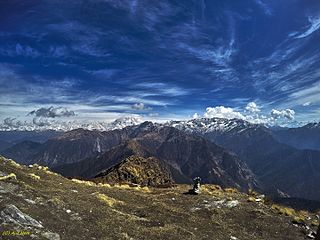
Chandrashila is the summit above Tungnath temple in India. It literally means "Moon Rock". It is located at a height of about 3,690 metres (12,110 ft) above sea level. This peak provides views of the Himalayas, including Nandadevi, Trisul, Kedar Peak, Bandarpunch and Chaukhamba peaks. There are various legends associated with this place. According to one such legend, this is where Lord Rama meditated after defeating the demon-king Ravana. Another legend says that the moon-god Chandra spent time here in penance.

Chopta is a small region of meadows and evergreen forest area, a part of Kedarnath wildlife sanctuary located in Uttarakhand state, India and a base for trekking to Tungnath, the third temple of Panch Kedar which lies 3.5 kilometres (2.2 mi) away. Located at a distance of 1.5 kilometres (0.93 mi) from Tungnath is Chandrashila, a summit rising to over 4,000 metres (13,000 ft).

Ukhimath is a small town and a Hindu pilgrimage site in Rudraprayag district, Uttarakhand in India. It is situated at an elevation of 1,311 meters and at a distance of 41 km from Rudraprayag. During the winter, the Utsava Idols from the Kedarnath Temple, and Madhyamaheshwar Temple are brought to Ukhimath and worshipped here for six months. Ukhimath can be used as center destination for visiting different places located nearby, the Madhyamaheshwar Temple, Tungnath Temple and Deoria Tal and many other picturesque places. According to Hindu Mythology, the wedding of Usha and Aniruddha was solemnized here. By name of Usha this place was named as Ushamath, now known as Ukhimath. King Mandhata had performed severe penances to Lord Shiva here. During the winter, the Kedarnath and Madhyamaheshwar Temples are closed due to heavy snowfall in the area. As a result, the Utsava Idols of Kedarnath and Madhyamaheshwar are brought from Kedarnath and Madhyamaheshwar to the Omkareshwar Temple in Ukhimath. The winter puja of Kedarnath and Omkareshwar is performed here. The Omkareshwar Temple is located at Ukhimath, which is at a distance of 41 km from Rudraprayag.
Uttarakhand is a state in the northern part of India. It is often referred to as the "Devbhumi" due to its religious significance and numerous Hindu temples and pilgrimage sites found throughout the state. As a result, religious tourism forms a major portion of the tourism in the state. Uttarakhand is known for the natural environment of the Himalayas. 2019 Tourist Arrivals Domestic – 40,000,000 per/year and Foreigner – 150,000 per year. Tourism business in Uttarakhand generated ₹ 23,000 crores during 2013–14.

Doleshwor Mahadeva is a Hindu Temple of Lord Shiva located in Suryabinayak, south eastern part of Bhaktapur District, Nepal, and is believed to be the head part of Kedarnath temple located in Uttarakhand, India.
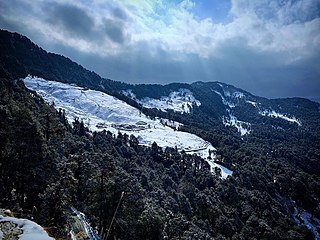
Chopta Bugyal, also known as "Tungnath Bugyal" or "Rohini Bugyal", is a cluster of Bugyals in Chopta, Rudraprayag district of Uttarakhand. Chopta Bugyal is a trekking and camping destination. The Bugyal has an average elevation of 2,849 m (9,347 ft) and is around 30 km (19 mi) from Ukhimath. It is situated on the trek route to Tungnath, the third temple of the Panch Kedar and the highest Shiva temple in the world and Chandrashila, a summit at an altitude of 3,645 m (11,959 ft). Chopta Bugyal is surrounded by forests of pine, deodar and rhododendron and is rich in flora and fauna.

